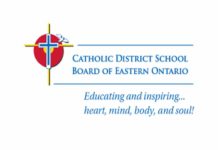School Year Calendar
2022-2023:
Regular and modified school year calendars are required to be submitted to the Ministry of Education on or before March 1, each school year. The Ministry provides guidelines to school boards for developing school year calendars and Regulation 304 outlines the requirements for preparation and submission of school year calendars to the Ministry of Education.
The first draft of the CDSBEO school year calendar for 2022-2023, was presented by Superintendent of School Effectiveness, Natalie Cameron, to the Board of Trustees. Dates were selected with special consideration given to the timing of Labour Day 2022 and following all Ministry of Education guidelines.
“Planning for the calendar begins with a Ministry of Education template that is provided to all boards in the province,” began Superintendent Cameron.
“Once a draft was created, the consultation process began. It is important to align the school year calendar with our co-terminus public board, which we have done where possible, to minimize costs associated with the transportation of our students. It is also important to take into consideration the French Catholic and French public boards. Both Boards were provided with our draft calendar to try to ensure collaboration around the Christmas and March Break holidays.
In addition to consultation with other school boards, feedback was collected from schools, various committees, staff members, unions, the parent community, and other stakeholders. Under the proposed modified calendar, the first day of school would be Tuesday, September 6, with the two-week Christmas break beginning Monday, December 26.
“We have done a thorough consultation with other boards to ensure this calendar meets the needs of our community, our parents, our students and our staff,” concluded Superintendent Cameron.
Computer Science Week 2021:
Coding allows users to investigate, problem solve, explore, communicate through discovery, and express ideas creatively. It requires computational thinking, which is embedded throughout the Ontario Curriculum. Educators can incorporate code into learning for all curriculum areas, as it is a fundamental computational thinking skill of the modern world.
During the month of December, CDSBEO schools participated in Computer Science Education Week. The week provided an opportunity for students to embrace coding through various learning opportunities. Principal of Curriculum Tracy O’Brien, and Jameson Lee, Technology Enabled Learning and Teaching Contact, presented information to the Board of Trustees.
In 2020, coding became part of the mathematics curriculum in the algebra strand. Students in grades 1 to 3, build on key skills year over year. Scratch is a program which was developed by MIT. It allows students to use a drag and drop tool to program computer sequenced animation. There are blocks of code for motion and sound.
“At the elementary level, code is usually represented through blocks that are easy to identify and use for students. In high school, there are still instances of students using blocks for coding, but most coding occurs following specific coding languages. Like learning a foreign language, it takes time, and different rules must be followed in order for it to work,” noted Principal O’Brien.
During The Hour of Code, students and teachers worked together to build an inclusive environment that contributed to each other’s success. Students worked together to solve problems when they created and tested their coding projects. Students embraced a growth mindset, were excited to try new things, and developed critical thinking skills and creativity when working individually and with peers.
“Computer Science Education Week is recognized worldwide, and the CDSBEO usually celebrates the Hour of Code during the first week of December. As in other years, the Curriculum Department sent resources to all schools within the system, however, this year we extended our Hour of Code to support teachers, classrooms, and schools throughout the entire month of December. Extending our CDSBEO Hour of Code gave teachers more flexibility to try new things. We were able to offer consultant support, which increased participation in CDSBEO schools,” explained Lee.
The Curriculum Department provided lesson plans to all staff to facilitate learning. A Microsoft Team was created for advanced learners and classrooms looking for additional resources. Many CDSBEO staff were thrilled with the level of student engagement and feedback from educators allowed the Curriculum Department to look at next steps for supporting the student coding journey. Additionally, teachers received a “Request for Support” form, where they could request assistance from a consultant for planning or co-teaching purposes.
Moving forward, math consultants will be supporting intermediate students through recently purchased coding kits containing Sphero Bolts and Micro:bits for all schools. These kits build on previous years’ initiatives and bridge the skills from primary to junior and intermediate grades. Additionally, the lending library continues to be popular with schools, providing teachers with different types of robots to borrow and explore coding opportunities.








